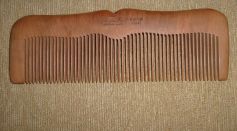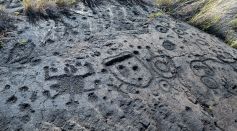Tags: Archaeology

Oldest Wooden Comb, Gold Hair Ring Discovered in British Bronze Age Burial, Revealing Prehistoric Craftsmanship

Roughly 40 Ancient Rock Carvings, Petroglyphs Found in Sweden; Depictions Include People, Animals, Ships

Prehistoric Skeletons Discovered Inside 7,000-Year-Old Stone Tomb in Oman; Human-Made Structure Is One of the Oldest Ever Found in the Country

Unearthed Woman's Centuries-old Thigh Bone in Portugal Observed To Have Rope-like Lump; Archaeologists Think It May Have Resulted From Extreme Trauma

Ancient Europeans Took Hallucinogenic Drugs 3,000 Years Ago, Study Says; This May Have Led to Hallucinations, Delirium

Archaeological Gem: Oldest Known Tartan Piece in Scotland Stayed in a Bog for 400 Years; How Was It Kept Preserved?
Nearly 1,000-year-old Brick Tomb Discovered in Northern China by Workers Renovating Stormwater Drains

10 Ancient Egyptian Discoveries That Have Left Scientists Impressed and Terrified: Check Out Which Ones Made the List!

7,000-Year-Old Monuments in Arabian Desert Were Used For Rituals, Pilgrimages, Sacrifices, Burials

Ancient Inscription of Persian King's Name on Pottery Shard Is Fake, Israel Antiquities Authority Confirms

Byzantine Gold Earrings Coated With Gems Found in an 800-Year-Old Collection in Germany

30-foot-long Corridor Kept Hidden Above Great Pyramid of Giza; Archaeologists To Probe Deeper Into the Empty Chamber's Mysteries

Ancient Puebloans Established a Great Mysterious City in Today's New Mexico; Here's How They Could Have Done It

Egypt's 'Book of the Dead' Photos Revealed; What Was the Purpose of These Ancient Scrolls?

Earliest Brain Surgery? Researchers Find Evidence of 3,500-year-old Failed Cranial Operation in Israel

300 B.C. Woman Buried Facedown With Nail in Skull Reveals Prehistoric Beliefs About Epilepsy

Facial Approximation Shows Lifelike Face of Brazilian Man "Zuzu" From 9,600 Years Ago; Can Skeletal Remains Be Used To Know How a Person Looks Like?

Demon Slaying Weapon? Huge 7-Foot Sword From Japan Could Have Been Used To Protect the Dead Against Evil Spirits

Ancient Egyptian Pyramids Were Covered in Shiny White Limestone Thousands of Years Ago, Researchers Say

Workshop For Making Axes? Almost 600 Obsidian Handaxes From Over a Million Years Ago Were Uncovered in Ethiopia
Most Popular

Largest Known Volcanic Aquifer Discovered Beneath Oregon's Cascades

New 'Supergiant' Sea Bug Found in South China Sea, Named After Darth Vader

Mediterranean Sea Was Refilled by a Catastrophic Flood Millions of Years Ago

Mysterious Cosmic Waves That Sound Like Birds Detected in Unexpected Space Region





